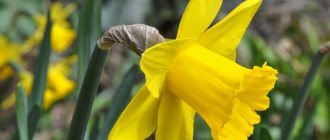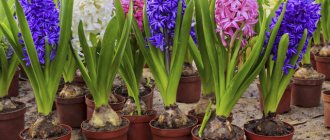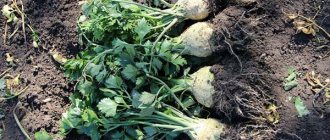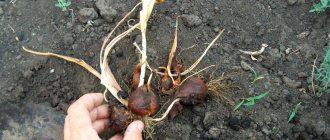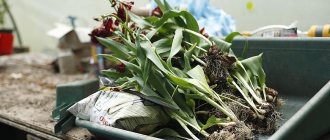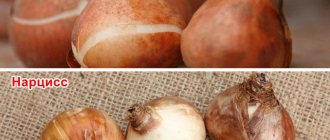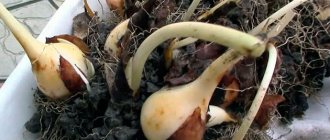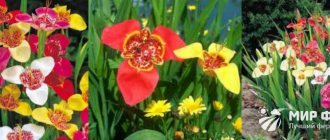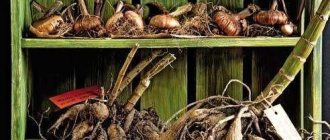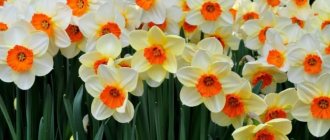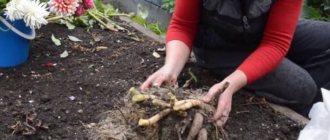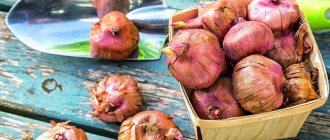There comes a time when hyacinths, having pleased you with their early flowering, begin to fade and questions arise about what to do with faded hyacinths and how to organize care for hyacinths after they bloom.
There are several options, each of which can be chosen depending on the place where the flower grows (garden or indoor growing) and the degree of desire to care for the faded plant. Often donated hyacinths are simply thrown away - what else can you do with hyacinths after flowering? But sometimes such flowers open the way to starting indoor floriculture, because growing hyacinths at home can easily be continued after the first flowering. You just need to know what to do with hyacinth bulbs after flowering and how to preserve hyacinth and learn how to properly store hyacinths (bulbs) after flowering has ended.
Selection of bulbs and varieties for forcing hyacinths at home
Any varieties are suitable for early (blooming in November-December), middle (January-February) and late (March-April) forcing. But growing indoors has its own favorite varieties, which are less likely to cause problems.
Reliable options:
- white variety "Innocence" (La Innocence),
- orange-fawn “Harlem” (Haarlem),
- pink "Garibaldi" (Garibaldi),
- red "Moreno "
- blue “Pride of Holland” ,
- lilac-blue “Grand Maitre” .
Especially good for forcing for the winter holidays:
- blue variety "Ostara "
- purple "Amsterdam "
- pink “Anne Marie” .
“Amethyst” are suitable for spring forcing - “Pearl Brilliant”, “ Pink Pearl”.
To get optimal results, it is better to use special varieties and bulbs for forcing. Large, carefully selected, and, most importantly, already treated with drugs, purchased bulbs cause less trouble and appear on sale in large quantities in the fall. They have passed the ideal storage period outside the soil and are ready to plant.
Hyacinth "Harlem" (Haarlem).
You can, of course, use “ordinary” hyacinths, but they must be selected carefully. Only very large bulbs, with a circumference of 17-18 cm, are suitable for forcing (it is more convenient to use a weight measure - from 80 to 100 g). The bulbs must be in perfect condition, dense, weighty, without damage, traces of mold, drying out, rot or improper storage. If you dig bulbs in your own garden, then for early forcing you need to have time to dig them up in the last ten days of June, and for middle and late ones - in the first ten days of July.
Before planting, any hyacinth bulbs should be stored in a dark and medium-cool, always dry place.
Preparing garden, regular, untreated hyacinth bulbs begins with properly processing them. To make forcing go faster (the same as with purchased bulbs for forcing), it is better to soak the bulbs in a solution of a root formation stimulator for about 2 weeks. They are carefully placed with the bottom down in shallow containers and the working solution prepared according to the manufacturer’s instructions is poured into it so that 2 cm from the bottom is immersed in it. The treated bulbs are slightly dried before planting. It is advisable not to forget about dressing with fungicides.
Hyacinth "Pink Pearl".
Hyacinth "Ostara"
Proper planting of hyacinths at home
The timing of planting indoor hyacinths also determines the timing of their flowering. September is the start month for forcing hyacinths, when bulbs with an expected November-December flowering are planted. For winter holidays, planting is carried out during October, and for spring holidays - until December.
The best results are obtained by planting in September-October, therefore, in the first half of the month, plants are usually planted for the winter holidays, in the middle - by March, regulating the flowering time by temperature (lowering the temperature and shortening daylight hours to slow down growth).
Hyacinths are much easier to plant than other indoor bulbs. Large bulbs and standard containers are the only options for them when grown in soil. The easiest way to plant hyacinths is one bulb at a time, in pots 9-10 cm in diameter with good drainage holes. When planting in a group, leave 2.5-3 cm from the walls and between the bulbs, calculating the number of plants according to the diameter of the pot.
It is better to cover the drainage holes with a mesh or scoop. Despite the fact that bulbous plants are often planted without drainage, laying it is the best guarantee that serious mistakes with watering and death from rot can be avoided. Even coarse sand will do.
Hyacinths grow better in a special substrate for bulbous plants, but in general, they are unpretentious to the soil. If the soil is nutritious and loose, garden soil with added sand, a universal substrate, and a peat-sand mixture (3 to 1) will do.
The planting itself is extremely simple; for hyacinths there is no need to calculate the depth:
- The pots are filled with substrate almost to the brim, without compacting.
- The bulb is placed in the center, gently pressing it into the soil and squeezing it with the substrate. The bulb should not protrude above the edge of the container, but the top should not be covered with substrate, deepening it to approximately ⅔ of the height.
- Carry out careful watering and, if desired, mulch the soil with sand.
If hyacinths are grown in water or hydroponically - in flasks, glasses, glasses, the diameter of which corresponds to the size of the bulb and allows it to be installed “reliably”, then the bulbs simply need to be installed above the water (so that the bottom does not touch the surface of the water, but is as close as possible to it, 0.5-1 cm). Fertilizers for hydroponics or bulbs and a small amount of charcoal are added to the water.
September is the month when hyacinths began to be forced out.
Rooting period for home hyacinths in the dark
You cannot achieve quick results with hyacinths. The period of rooting and the beginning of growth after planting takes 2-2.5 months for treated bulbs, and 2.5 to 4 months for regular bulbs. And all this time you need to keep the bulbs cool (from 4 to 8 degrees Celsius), dark (possibly under an impenetrable cover) and at high air humidity, about 90%.
To create ideal light soil moisture, you can carry out rare, slightly soaking soil or gentle bottom watering, without allowing the soil to dry out completely. If there are a lot of containers, you can place hyacinths in a box (cardboard or wooden) in damp sand, sawdust, sphagnum, peat, filling the gaps between the pots and covering the bulbs with a layer of about 2-3 cm on top.
The “filler” creates a special microclimate provided it is regularly moistened. And for hyacinths planted in flasks and glasses, it is enough to maintain a stable water level.
Diseases and pests of hyacinths
Hyacinth diseases and their treatment
Hyacinths grown in open ground are extremely resistant to infections. Greenhouse and forced plants suffer from diseases more often. If storage conditions are violated, hyacinth bulbs can be affected by penicillosis, or storage rot, which is caused by fungi of the genus Penicillium. Penicillosis pathogens are activated when bulbs are stored at temperatures below 17 ºC in conditions of high humidity. Planting material with mechanical damage is especially susceptible to infection. A sign of penicillosis is drying of the ends of the roots, which is usually detected before planting. If you make a cut just above the bottom, you can see that the internal tissues have acquired a light brown tint. Invisible from the outside, the rotting process continues during and after planting infected bulbs, which either do not form roots at all or do not form enough roots. In such plants, the flower stalks do not gain height and break easily. In places of infection, fungal colonies appear on the bulbs, the tissues become soft and darken.
To avoid the development of infection, store hyacinth bulbs in a well-ventilated area, with air humidity not exceeding 70%, and immediately plant bulbs with prematurely grown roots in the ground.
Yellow bacterial rot can affect hyacinths, turning plant tissue into foul-smelling mucus. Symptoms of the disease include stunted growth, the appearance of spots and stripes on the leaves and flower shoots, and then rotting areas. The bulbs also suffer from the disease. When the first signs of bacterial rot are detected, the diseased plant should be dug up and burned, and the place where it grew should be spilled with a five percent solution of Formalin or bleach.
Pests of hyacinths and their control
Of the insects, garden hyacinths are pestered by flower flies, the larvae of which feed on the tissues of the bottom of the bulb. Flies are destroyed before laying eggs by treating the plants and the soil around them with a solution of the drugs Fly Eater, Tabazol or Aktara.
The meadow mite is also an enemy of hyacinths. Its activity occurs in late spring and early summer. The main danger of arachnids is that they are carriers of incurable viral diseases. Plants infected with mites have bent flower stalks, and leaves turn yellow and wither prematurely. Ticks are destroyed with acaricides - Actellik, Talstar Pro or other drugs of similar action.
A danger to hyacinths are mole crickets that damage flower bulbs directly in the ground. The activity of these insects begins in May, when they crawl out of the sun-warmed ground. To collect and destroy all pests, dig shallow holes in the area, spread fresh manure or half-rotted straw in them and cover the top with old slate or a piece of board. The mole crickets will crawl into the traps to lay eggs in them, and after 3-4 weeks you can begin to destroy them. Among pesticides, Medvetox, Medvezhatnik, Boverin, Grizzly, Thunder and other drugs of similar action have shown effectiveness in combating pests.
Period of active growth of hyacinths and budding with slowdown
Plants are transferred to new conditions when the shoots rise to a height of 4-5 cm, checking the quality of rooting and development of roots. The temperature is increased immediately or in several stages, to cool room temperature - from 15 to 22 degrees Celsius.
Hyacinths are accustomed to light gradually, moving them closer to the window or placing them on the windowsill immediately, but covering them with a paper cap. The cap is removed when the sprouts stretch to 8-10 cm, and yellowish leaves rolled into tubes appear.
Watering is increased gradually, from minimal to medium, maintaining light moisture in the substrate and allowing it to dry from above. Overmoistening is unacceptable. Air humidity should remain high (from 90%) and combined with frequent, careful ventilation. You can start spraying the leaves when they open and turn green.
At the budding stage, it is worth moving the hyacinths to the balcony.
From the moment unformed inflorescences appear until flowering, approximately a month (25-30 days) will remain. And the main secret during this period is the brightest possible lighting and air temperature from 16 to 18 degrees. A daylight duration of 12 hours or more is desirable; it can be adjusted by additional lighting. If you need to delay flowering, reduce it and lower the temperature (to speed it up, bring it to 14-16 hours and above 20 degrees).
Tuber harvesting time
There is no exact date for harvesting tulip bulbs. The choice of a specific number depends on many factors:
- climatic features of the area;
- bulbs are ready for harvesting;
- weather conditions;
- early maturity of the variety.
Only taking into account all the points, the optimal time is chosen. Tulip bulbs are planted in open ground in spring and autumn. The second method is often chosen.
Select date by region
For different climatic regions, the timing of harvesting tulip bulbs will vary. Depending on the region, the following deadlines are adhered to:
- in the southern regions they begin harvesting bulbs from the beginning of June;
- for the middle zone, the optimal time is the end of June - beginning of July;
- in the northern part, tulips are dug up only at the end of July.
More precise dates depend on the condition of the ground part, as well as on the early maturity of the variety.
Determining deadlines by appearance
Determining when the bulbs are ready for digging will inform the appearance of the out-of-this-world part. After flowering, tulips enter a dormant stage. The color of the leaves fades, they turn yellow and gradually dry out.
Such signs signal that the bulbs are ready; they have already collected all the nutrients. The ground part should not be allowed to dry out completely. If it falls off, it will be difficult to find the bulb nests. You can start digging up tulips from the moment when 1/3 of the foliage is dry.
Harvesting the bulbs early will prevent them from accumulating the required amount of nutrients. Next season this will affect the development of leaves and flowers.
When to dig according to the lunar calendar
The influence of the phases of the Moon on plants has been known since ancient times. If you carry out agricultural work in accordance with the lunar calendar, the flowering will be beautiful and the plants will be healthy.
You can dig up tulips in 2021 on favorable days determined by the lunar calendar:
- June – 23, 26-30;
- July – 2, 6, 9-10, 14, 17-18.
If you miss favorable numbers, you can carry out the procedure at any other time. Astrologers recommend avoiding only the periods of the New Moon and Full Moon.
Favorable weather conditions
If the bulb is young, the bud must be broken off until it opens. This point should not be ignored, because all nutrients will be spent on ensuring flowering, and not on the development of the underground part. In this case, there must be at least 2-3 leaves on the stem, otherwise photosynthesis will not be ensured.
To dig up the crop, choose a dry, cloudy day. The soil should dry out during this time. Excessive moisture is harmful to plants. If the digging period is coming to an end, and the weather does not stabilize, it rains, the bulbs will have to be dried additionally. To do this, lay out the planting material on newspapers or fabric indoors and keep it that way for about 1 week. This point cannot be ignored; the risk of tubers becoming rotten increases.
If the bulbs are excessively waterlogged and soft to the touch, their condition should be monitored. There are probably fungal spores under the scales. It is better to perform preventive treatment using fungicides.
Caring for hyacinths at home: changing conditions with the appearance of buds
To achieve the most magnificent and long-lasting flowering, you will need to lower the temperatures at the budding stage. At the same time, the lighting should remain just as bright. The best option is to move the hyacinths to a place where the temperature remains between 8-10 degrees (for example, to a balcony). If it is impossible to keep the plant in constant coolness (10-12 degrees), then when the first flowers bloom, they can be transferred back to a warm room.
This will affect the duration of flowering, but it will still be much longer than with constant heat. Watering remains the same, as does air humidity. Fertilizing begins from the moment the plants budding with special fertilizers for bulbous plants according to the instructions and ends with their flowering.
Note! On hyacinths at all stages, it is very important not to forget to carefully examine the leaves and inflorescences, because this bulbous plant is one of the most susceptible to pests and rot. Aphids and cutworms are not uncommon on hyacinths, but root mites are much more dangerous. It is worth fighting insects radically and quickly, immediately - with insecticides.
Treatment after excavation
When to plant tulips
In order for the storage period to go well for the bulbs, they need to be properly processed after digging:
- Do not immediately separate the roots and leaves. First, you need to carefully shake off the dry soil and leave it in a dry, dark place to allow the bulbs to absorb as many nutrients as possible from the above-ground part;
- after the roots and leaves have completely dried, you need to remove all excess and clear the remaining soil;
- the bulbs are washed with cool water;
- you need to warm them up in warm water or 20 minutes. hold Maxim in the solution of the drug;
- at the end you need to place the bulbs in a dry, dark place and leave to dry for 4-5 days.
A special processing method also promotes accelerated plant propagation:
- the bottom of the bulb is cut crosswise with a disinfected and sharp knife;
- dry the cuts.
This type of treatment stimulates the formation of new bulbs at the incision site.
How to cut bulbs
Note! When planting in the fall, there is no need to separate new bulbs from the mother bush; it is better to leave them to grow until the next season.
Secrets of successfully forcing hyacinths at home
Hyacinth is one of the most popular bulbous flowers for forcing. I make sure to remove the hyacinths from my apartment every year to “speed up the arrival of spring.” In general, this is a very unpretentious flower that is always ready to please with its fragrant flowers. That is, forcing this plant is possible even for novice gardeners. However, hyacinth also has some “pitfalls” that it is better to know about in advance. I will talk about what problems may arise when forcing hyacinths, how to avoid and prevent them, in this article.
Secrets of successfully forcing hyacinths at home.
Rare ear - how to avoid?
We all know hyacinth as a plant with a densely packed spike-shaped inflorescence. Manufacturers of planting material on bulb packages also always depict hyacinth as such a lush beauty. But why do we sometimes end up with spikelets of rare flowers, sitting quite far from each other?
This feature not only reduces the decorative value of the plant, but also reduces its overall flowering period. After all, the more flowers an inflorescence has, the longer it will bloom. In fact, there may be several reasons for this problem. Let's look at them separately.
Too young bulbs
Another reason for a sparse peduncle is a young bulb. Typically, bulb planting material is mainly designed for planting in the garden and subsequent growing. In this regard, these may be fairly young bulbs that may not yet have gained enough strength to produce lush flowering in full accordance with the varietal characteristics.
Take a closer look at the blooming hyacinths that arrive in abundance in stores for the spring holidays. Such planting material is selected exclusively for forcing, that is, to obtain the most spectacular inflorescences. Therefore, there we most often see huge bulbs, which are 1.5-2 times larger than those intended for planting in the garden.
And, of course, a year before they were sent for forcing, the plants were fed very intensively, which is usually not done with simple planting material. As a result, the splendor of flowering in the first and second ones can differ significantly.
The bulbs did not have enough heat or nutrition
This can happen if the bulbs were not stored correctly in the summer, or if you used plants that grew in your own garden for forcing. As you know, many bulbs require sufficiently high summer temperatures so that they can set buds for lush flowering in the next season.
But in the middle zone, summer is not always hot and not too rainy. That is why varietal tulips, some onions, hazel grouse and hyacinths are recommended to be dug up after the end of flowering and the subsequent death of the foliage. During this period, planting material should be stored in a dry, ventilated area at a special temperature. In the first two weeks +25...+30 degrees, in the next two months +22...+23 degrees, then until landing +12...+18 degrees.
When planning to force the hyacinth from your own bulbs the previous season after flowering has completed, you need to feed it well before it completely sheds its foliage. Lack of nutrition can also lead to a looser ear.
It makes no sense to feed hyacinth from purchased bulbs in the budding phase already during forcing; this will not improve the quality of the flowers. Bulbous plants lay flower buds last season. Spring bloom only reflects how good its growing conditions were last year. This is why hyacinths are also often grown in plain water, because all the nutrients and flower buds are already present inside the bulb.
It is better to bring hyacinths (Hyacinthus) into a warm place when the bulbs have “spouts” of at least 3-4 centimeters.
Do I need to dig up hyacinths annually?
Hyacinths must be dug up annually to preserve their varietal characteristics. In order for a bud to emerge in the tuber, the tuber necessary for flowering in spring must be stored in favorable conditions at a temperature of 26-30 ° C. For example, in regions such as the Moscow region, such temperatures in the soil do not occur in winter.
Additionally, digging up flowers each year reveals damaged bulbs that may be preventing healthy plants from growing. They need to be removed from the growing area.
Hyacinths open buds of different colors
This also allows you to avoid a number of consequences:
- planting material degenerates and blooms worse;
- problems with reproduction appear;
- high likelihood of contracting the disease.
Note! For better growth, reproduction and flowering, hyacinths must be dug up annually.
Insufficient cooling period
According to my observations, the quality of hyacinth flowering can also be affected by an insufficient cooling period of the bulbs before forcing. That is, the period of cold rooting is too short. On average, for successful forcing, it is necessary to cool the bulbs for at least 2.5 months.
I always refrigerate my hyacinths at the beginning of October and make sure that the dormant period is approximately 3-3.5 months. By the way, there are no special tricks when planting hyacinths. For forcing, I choose wide, low dishes, which I fill with the most inexpensive commercial substrate. I water it generously and bury the bulbs about 2/3 or even a little deeper. It is necessary that the bulb is only slightly visible from the ground, since sometimes when the roots grow it can be turned out of the substrate.
If there are no severe frosts during this period, then, in order not to take up space in the refrigerator, at first I keep the plantings on the open balcony. As soon as significant cooling is predicted, I put them in the refrigerator in the vegetable section, where they are kept at a temperature of +4 degrees. If there is a basement, they can also be placed there if the room temperature does not exceed +9 degrees. I water it a little about once a month if the soil seems a little dry.
Storage methods
It is easy to determine that the planting material is ready for the last stage: if the old corm is easily separated from the new one, you can pack the seeded gladioli in storage containers.
Method 1
Cardboard or wooden boxes will come in handy; you can stock up on plastic containers. The main thing is that they have holes for ventilation.
- Wrap each bulb in a piece of newspaper or clean paper.
- Place in boxes. To prevent pests, pour naphthalene into the container. An alternative is 3-4 cloves of peeled garlic.
- If the basement is damp, put the box of gladioli in the refrigerator. A bottom shelf designed for storing fruit is suitable.
Method 2
Place the bulbs wrapped in newspapers in a vegetable net. Store in the basement or refrigerator at +5–8 degrees, and humidity not higher than 85%. To repel pests, add a few cloves of peeled garlic.
Method 3
Remove the top husks from the bulbs. Heat the paraffin and immerse each one in the liquid product. When planting, do not wash off the protective film.
Common mistakes
- Do not remove the top husk from the bulbs. It protects planting material from drying out. The exception is when processing with paraffin.
- You cannot store gladioli in plastic bags, even those with holes. They do not allow air to pass through well, and condensation accumulates inside.
- Germinated planting material must be moved to a cool room with diffused light.
Harvesting and storing gladioli is not as troublesome and complicated as it may seem to novice gardeners. It is enough to remove the bulbs from the ground in a timely manner, properly dry and process them, and in the spring they will delight you with friendly shoots and beautiful flowers.
Peduncles are too elongated or excessively short
When forcing hyacinths, their flower stalks often grow too long, bend under the weight of the inflorescences and require garter. This greatly spoils their appearance. In another case, we observe “dwarf” hyacinths, when the arrow does not extend at all, and the flowers begin to bloom, being squeezed by foliage that has not even really grown back. These two seemingly completely opposite problems have common roots.
After the end of the cold rooting period, when you transfer hyacinths to heat, it is very important to observe certain conditions. It is best to get hyacinths when the bulbs have “spouts” of at least 3-4 centimeters, and not just when they have begun to sprout. Logically, you immediately want to place the plants on a sunny windowsill. You can't do that! This is what most often provokes underdevelopment of the peduncle with premature blooming of flowers inside the foliage.
At first, it is recommended to keep hyacinths in shade for about a week so that the flower arrow stretches upward. At the same time, the temperature regime is no less important. If hyacinths stand in the shade in a hot room, we will get elongated, lodging flower stalks. The optimal temperature at this time is +16…+18 degrees. And only when the shoots actively begin to grow and reach a height of about 10 centimeters, they can be exposed to light and kept at normal room temperature above 20 degrees.
However, problems with flower stalks sometimes occur for other reasons. In particular, an underdeveloped shortened peduncle may also be a consequence of an insufficient period of cold rooting (less than 2.5 months) or this can be caused by poor watering. If the peduncles are too elongated, in order to avoid their lodging, feed the hyacinths with a 0.2% solution of calcium nitrate.
When forcing hyacinths, their flower stalks often grow too long, bend under the weight of the inflorescences and require garter.
How to plant hyacinth, practical recommendations
The optimal time for planting hyacinths is the beginning of October. Before the soil freezes, the bulbs have time to take root and gain some strength before wintering. It is better to prepare the area where you plan to transplant hyacinths after flowering in advance. To do this you need:
- choose a place where there is a lot of sun and where water does not accumulate;
- cultivate the soil to a depth of 30-40cm;
- add humus and mineral fertilizers.
Don't rely on the weather to plant bulbs. If you see sunny weather and plant the bulbs ahead of schedule, then the hyacinths that have begun to grow may die in winter. And if you hold them too long and plant them later than the first half of October, then there is a chance that they will not have time to take root before the soil freezes.
In the fall, the bulbs driven out at home are planted in open ground. This must be done before the first frost. Moreover, if the weather is unfavorable, planted hyacinths are well insulated, covered with a layer of leaves or protective film from rain and snow.
By reading our recommendations on how to care for hyacinth after flowering, you will certainly extend the life of this plant in your garden and enjoy its bright and fragrant flowers. But finally, I would like to note that in order for there to be no problems with peduncles, and the bulb grows healthy and strong, you must adhere to the basic rules:
- ensure a sufficient dormant period for the bulbs;
- observe the temperature regime and appropriate humidity during forcing;
- provide optimal lighting during forcing of the peduncle;
- Fertilize with appropriate fertilizers in a timely manner.
And there is not a single drop of doubt left that you will turn out to be a wonderful, caring and experienced gardener. The last step is to be patient, purchase bulbs and plant a small lawn of hyacinths in the fall, so that in the spring a colorful and fragrant hyacinth carpet created with your own hands will delight the eye.
Video of planting hyacinths in autumn
Hyacinths not blooming?
Sometimes it can happen that a seemingly fully developed peduncle with a mass of buds does not bloom. Taking a closer look, you will find that the buds only at first glance seem to be alive, but they consist of completely dried petals. The reason for this situation is simple - the hyacinths simply did not have enough water. Watering was either rare or too scarce.
The fact is that hyacinths, like any other primroses, bloom in nature in spring, when the earth is saturated with moisture after the melted snow. Humidity is high and it rains often. In city apartments, the situation is the opposite - dry air from central heating and a small container. If you add untimely watering to this, then the hyacinth simply does not have enough moisture to open the buds.
And there is only one way out - strictly monitor the soil moisture during the budding period. At the same time, overflow is also contraindicated for bulbous ones, and the container must have drainage holes for the outflow of excess water. By the way, untimely watering can also lead to hyacinth flowering too quickly.
What to do with hyacinth bulbs after flowering
During storage, future inflorescences are formed in the tubers, so it is important to ensure proper and high-quality care for the hyacinth bulb after flowering. This involves the following steps
After peeling the onion, it must be washed well. Next, the bulbs must be soaked for several hours in a weak solution of potassium permanganate - this will ensure disinfection, and the likelihood that diseases and pests will damage the hyacinth during storage is reduced to zero. After this, the bulbs are well ventilated and dried in the sun.
It is important that there is no moisture left on them, otherwise rotting may begin. After drying, hyacinth tubers should be placed in a dark room with an air temperature of about 20 degrees for 5-7 days.
Once you have completed these steps, you can be sure that your bulbs will successfully overwinter, and each of them is guaranteed to germinate and bloom in the spring. During the wintering period, just in case, the bulbs can be taken out of storage several times, sprinkled with mineral fertilizers, allowed to dry and placed again in the box. This will help the flowers gain strength.
When to dig up hyacinths after flowering?
When giving recommendations on when to dig hyacinth tubers from a pot after flowering, it is difficult to be tied to the time, because forcing these flowers at home is very different from growing them in open ground. Outdoors, hyacinth blooms no earlier than in April. And at home, it’s easy to schedule flowering by a certain date - by the New Year or by March 8, for example.
After the hyacinth fades, the peduncle remains green for some time, then it begins to dry. After this, the flower looks full of strength for another month or more, and then its leaves begin to rapidly dry out. Don’t be alarmed - this is a normal process, the plant is preparing for winter. When the leaves completely dry out and the hyacinth looks completely lifeless after flowering in a pot, it’s time to dig it up and prepare it for winter storage.
Storing hyacinth bulbs after flowering
The first thing to organize after you have dug up the bulbs is where to store hyacinths after flowering? It should be a well-ventilated container; a wooden box or cardboard box is ideal. It is better not to use plastic - there is no air circulation in it; you can only use plastic boxes with mesh walls and bottom.
Place the hyacinth bulbs in the box carefully so as not to hit the bulbs
You can’t pour them in – it’s important to take one at a time and place it carefully. It is better to lay out hyacinths in no more than two rows
Bulbs are stored in two stages.
The first stage lasts at least two months, depending on how early flowering you plan on. The box with the bulbs is placed in a warm room - the air temperature should be 25-26°. If you want to shorten this stage and speed up the processes, the temperature should be raised to 30°. The second stage is called pre-planting, and it lasts a month. Flowers must be placed in a cool room with an air temperature of 17-18°
It is important to monitor air humidity - if it is too low, the bulbs may dry out
Immediately before planting, it is important to once again inspect the tubers for damage by parasites and rotting. Often during wintering, the bulbs become overgrown with numerous children - they must be carefully separated, and they are also suitable for planting in separate pots. But be prepared for the fact that they will not bloom in the first years - it takes about 3-5 years for the small bulbs to gain mass
Color Mismatch
If we do not take into account the possibility of a banal re-cultivation, there are other reasons why a flowering plant may not correspond to the bright picture on the packaging. The main reason for flowers that are more faded than expected is lack of lighting.
Most often, hyacinths are driven out without any additional lighting and sunlight on the windowsill may well be enough for them. However, lack of light can affect the intensity of some colors. Fortunately, this problem does not affect dark-colored varieties: lilac, crimson, purple and blue. But the shade of colors that are rarer for hyacinth can vary greatly.
In particular, hyacinth is not bright yellow even in open ground, and on the windowsill it will definitely be more of a lime color with a yellowish tint. Why then in numerous photos we see hyacinths that are richly yellow, like chickens, we can only guess. Either they don’t have enough light in temperate latitudes, or are these all “miracles” of photo editors?
In any case, having tried all the available varieties of yellow hyacinths in my garden and on the windowsill, I can say that absolutely all of them turned out to be very, very pale. The situation is similar with orange hyacinths. At best, the orange varieties gave me pale salmon-colored petals, and often they had pinkish hues without a hint of orange. Therefore, I am afraid that the rich orange hyacinths, the color of a ripe apricot, exist only in a picture. And another common hoax is red hyacinth. In reality, red varieties turn out bright pink.
Having tried all the available varieties of yellow hyacinths, I can say that absolutely all of them turned out very, very pale.
Step-by-step instruction
After the foliage has withered and turned yellow, you can remove the bulbs from the soil. When digging, you need to adhere to the following procedure.
- After the hyacinth has bloomed, you need to start actively caring for the plant so that the bulbs gain nutrients before resting (loosening the soil, regularly watering with warm water and fertilizing with mineral fertilizers). But a few days before you plan to dig up the hyacinth, you need to stop fertilizing and watering it.
- Digging should be done in dry, clear weather so as not to damage the roots and the bulb itself.
- Of course, you can remove hyacinth bulbs from the ground with a pitchfork or an ordinary shovel. But it is better to use a small garden trowel to avoid damaging the roots and splitting the bulb. Dig deeper into the ground to reach the body of the hyacinth with all its roots intact.
- After you have removed the hyacinths from the soil, you need to clean the bulbs from the soil (if the soil was wet, it is better to wait until the soil dries so as not to damage the plant) and dry husks. And also rinse with warm water. If the leaves are not completely dry, then it is better to leave the bulbs for a couple of days in a cool, ventilated area until the foliage is completely dead, so that the hyacinth absorbs all the nutrients. After this, cut off the dried shoots with special scissors.
- The dried bulbs need to be sorted out, separating the diseased and small ones (small “babies” should be separated from the rest and dried, and then planted in pots so that they increase in size and are ready for transplanting into open ground). Afterwards, the plants should be treated with a solution of potassium permanganate.
Mold on the surface of the soil - is it necessary to fight it?
During the cold rooting period, when containers with hyacinths are in the refrigerator or in the basement, mold often forms on the surface of the soil, as well as on the bulbs themselves. For novice gardeners, this can provoke panic and suspicion that mold indicates a disease of the bulbs, which will ultimately lead to their rotting.
In fact, mold is a common occurrence when forcing hyacinths and other crops. Its appearance is due to favorable conditions for its growth - lack of light and high humidity. But as soon as the container with hyacinths gets into normal room conditions, and later on a sunny windowsill, this problem will be resolved on its own. Very soon there will be no trace of mold left, and its existence in the past will not cause any harm to the bulbs.
If you are still very concerned about the presence of mold or there is too much of it, then it is enough to spill or spray the soil with any fungicide. In particular, bacterial preparations (Fitosporin, Trichodermin, Alirin, etc.) are very helpful in this case. To prevent the appearance of mold, you can add crushed Glyokladina tablets to the top layer of soil.
Is the strong aroma of hyacinths a problem?
Hyacinths have a very contradictory aroma, the perception of which depends not only on the subjective preference of a particular person, but can also vary greatly depending on the variety. Therefore, the smell of hyacinth can be described as both “very unpleasant” and “incomparable floral.”
In this regard, if you have never expelled hyacinths before, it is worth keeping in mind that you may not really like their smell. Personally, I associate this aroma with the approach of the long-awaited calendar spring, although I also sense some unpleasant notes in the aroma of certain varieties.
According to my observations, blue hyacinths smell most gently and pleasantly, but at the same time quite intensely. But the most unpleasant notes, ironically, are found in rare colors, in particular salmon and yellow. Blue hyacinths most often smell moderate, slightly bitter and quite pleasant. Among them you can also find varieties that are completely devoid of aroma.
It is worth driving out hyacinths with caution if there are people with allergies or people suffering from bronchial asthma in the house. There is also an opinion that in people prone to migraines and hypertension, the aroma of hyacinths can provoke headaches and increased blood pressure.
But at the same time, the smell of hyacinth has a positive effect on many people: it calms, relaxes and lifts their spirits. In any case, I would not recommend placing blooming hyacinths in the bedroom. In her apartment she gave them a permanent place in the kitchen.
